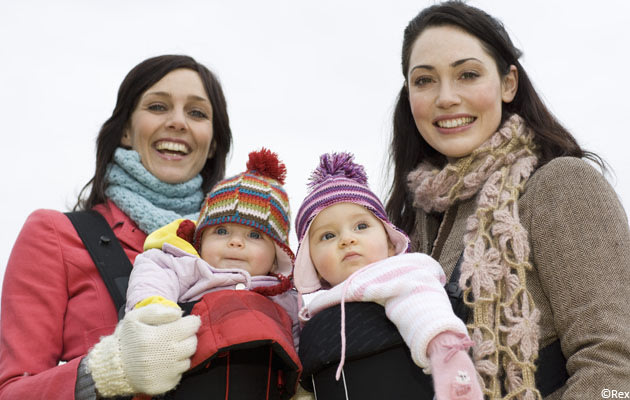
As the weather outside gets colder and the
central heating indoors goes up, make sure your little one is safe and
comfortable at all times, doesn’t overheat and avoids a chill.
This summer has made it more obvious than ever that the British weather
is completely unpredictable and constantly changing, which causes a headache
for parents of newborns. Tiny babies find it tricky to regulate their own
temperature in stable conditions, let alone the widely fluctuating hot and cold
flashes autumn brings.
Layering clothes means you can easily cool down or warm up your baby as required.
But, don’t let the autumnal weather stop you from venturing outdoors with your
little one in her first six months. Just take a little extra care to ensure she
stays a safe and comfy temperature - here's what to watch for.
When is it safe to take your baby outside?
You may venture outside with your baby as soon as you wish – there’s no
set age. However, newborn babies up to the age of about six months only have a
limited ability to regulate their own body temperature, so it’s up to mummy and
daddy to do this for them.
It can be tricky; even just a walk to the shops involves many different
temperatures, from the brisk winds outdoors, to the busy bus or train to the
warm coffee shop. It’s best to dress your baby in several thin layers – that
way you can shed a layer if needed. As a rule, dress your baby in one more
layer than you would dress yourself in, and add a warm hat, mittens and
insulating shoes or socks.
For older, walking babies, a set of waterproof trousers and wellies are
a must-have. And if, or when, snow sets in (here’s hoping for a white
Christmas!) let your baby join in the magic by dressing her in an all-in-one
snow suit. Snow suits aren’t practical unless it is extremely cold however, as
they can be a struggle to take on and off and can lead to overheating if worn
indoors.
If your baby seems uncomfortable at any point when you are outside, take
her inside to warm up.
Many paediatricians recommend you keep your baby away from crowded
places, as this is where germs are most likely. Autumn is the beginning of the
cold and flu season so ask anyone who touches your baby to wash their hands
first – it’s better to be safe than sorry.
How can you make sure your baby isn’t getting too hot?
It’s important to regularly check your baby whether you are indoors or
out, as babies’ cooling systems are not as effective as adults.
- Check by placing your hand under the clothes to feel the skin on your baby’s chest, tummy or nape of her neck. It’s best to avoid the hands or feet as a baby’s extremities often feel cool.
- If her skin feels more than just warm to touch, or if she’s perspiring, remove a layer of clothing and test again in a few minutes
- If her skin feels cool, add another layer.
- A more scientific way to keep an eye on temperature is by using a thermometer. Nowadays, you can find a good digital thermometer without breaking the bank, which are easy-to-use and provide accurate results within a few seconds. This can provide valuable peace of mind, especially to first time parents. A rectal reading is the most accurate for babies, so your doctor may ask you to take this type of reading until your baby turns three months old (you might want to wait until you’re home to do this reading though). But once your baby is over three months, you can take your baby’s temperature under her arm, in the ear or orally. These three thermometers are easier to use on the go.
At home - what temperature should baby’s nursery be?
The NHS recommends keeping your baby’s room between 16 and 20 degrees
Celcius.
The beginning of autumn is when most households begin to turn on their
central heating, but think about the difference in time between baby’s bedtime
and your bedtime – if you’ve set a timer to go off at your bedtime, your baby
might be warm when you put her to bed, but cooler a few hours later. Check in
on her regularly and before you go to bed and add an extra blanket if
necessary.
If the nursery has a number of exterior walls, this may make the room
colder, but if the room is small without a large window, it may retain more of
its heat.
Keeping your baby warm enough at night
Running heating devices during the night are not very practical and as
the air becomes dry, it can cause your baby to cough or get dry skin.
One idea is to buy a baby sleeping bag – your baby can’t kick it off,
which means she will be less likely to wake up feeling too cold. In the winter,
choose a sleeping bag that’s no more than 2.5 togs. You can buy sleeping bags
for different ages, including for newborns. The Foundation for the study of
Infant Deaths recommends using a sleeping bag without a hood that is the right
size around the neck so your baby doesn’t slip down inside. Also, never use a
sleeping bag as well as a duvet, as your baby is likely to become too hot.
Don’t go by your own habits; go by your baby’s. If she is particularly
vocal and you can’t work out what’s wrong, it’s often likely to be because
she’s too hot or too cold. Be vigilant, but try not to obsess – keep tabs on
your baby and the perfect temperatures for her will soon become second nature
to you.
Yahoo Lifestyle
No comments:
Post a Comment